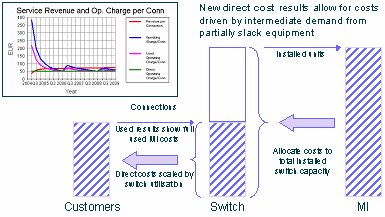 STEM
version 7.0 was released in September 2004 at the STEM User Group Meeting. This
milestone development embraces a new depth of analysis, including intrinsic support
for data services, a range of new financial calculations, and the addition of Service
results broken down by individual Resources. Clarity is the focus of this release,
enhanced by new formatting options in both the Editor and Result programs.
STEM
version 7.0 was released in September 2004 at the STEM User Group Meeting. This
milestone development embraces a new depth of analysis, including intrinsic support
for data services, a range of new financial calculations, and the addition of Service
results broken down by individual Resources. Clarity is the focus of this release,
enhanced by new formatting options in both the Editor and Result programs.
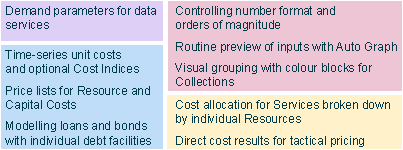
New features in STEM 7.0
Demand parameters for data services
The traditional Service traffic model is developed according to a voice-centric
methodology. The annual volume of calls per subscriber is the starting point, from
which busy-hour traffic is calculated as an estimated proportion of daily traffic:
BHT = Connx. ATpC. PropTiBH / BDpYr / UR
In previous versions of STEM, to model a data service it was necessary to specify
nominal bit-rates and contention ratios as User Data inputs, and then manually calculate
the volume of data transferred in a year as the Annual Traffic per Connection input.
Although this was regularly done by expert users, the procedure was far from intuitive.
STEM 7.0 makes it straightforward to model data services directly. The Service Demand
dialog has been extended to allow more intuitive entry of demand parameters for
data services. The new ‘Peak Driven’ calculation option works from new bandwidth
and contention inputs and makes annual traffic volume a calculated quantity.
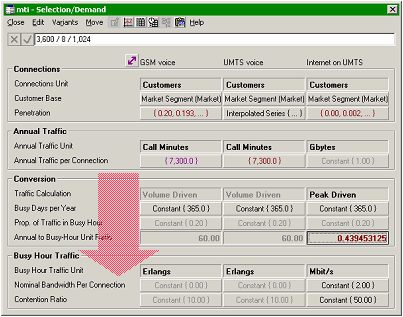
Multiple contention ratios
In general, there will be a contention ratio at the first point of aggregation,
on the immediate access pipe, where traffic may aggregate across, for example, other
dwellers of a multi-tenant unit. However, deeper in the core network, there may
be a further averaging effect due to multiple nodes coming together, resulting in
a higher overall contention ratio. This can be readily modelled through the multiplier
of an intermediate Transformation.
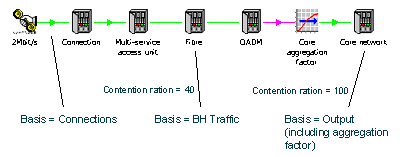
Progressive contention ratios in a data network
New financial modelling options
STEM 7.0 features a range of new financial calculations, as described below.
Time-series unit costs and inline trend for Capital Cost
Unit costs for a Resource in STEM were originally defined as a spot-value for a
calibration period, linked to per-Resource and global trends, and multiple cost
indices for capital costs. STEM 7.0 provides the flexibility users have asked for.
Unit costs are now time-series in their own right, allowing you to enter known or
linked time series directly and leave cost trends unset. But you can still enter
constant calibration values and use inline or global trends when this approach is
easier or quicker. A new Use Global Trends input also makes it possible to completely
decouple cost assumptions for certain Resources, while retaining global trends as
an efficient common hypothesis for the remainder.
STEM allows the capital cost of a Resource to be broken down into a number of constituent
cost trends via separate Cost Index elements. However, this complexity is excessive
in most cases, where one may be limited by time or data to a single trend at best.
Therefore, STEM 7.0 also has inline and global trends for the capital costs of Resources.
These work multiplicatively with the time-series unit cost input and capital cost
structure mechanisms, thus making Cost Indices optional.
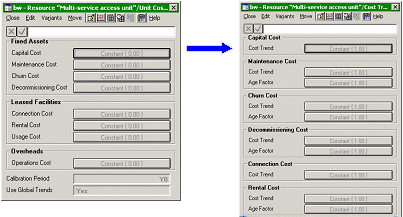
New inline trend for Capital Cost makes Cost Indices optional
Price lists for Resource capital costs
The smooth logarithmic model for economies of scale from earlier versions of STEM
has been replaced with a straightforward and intuitive price-list model which can
capture specific supplier price points. (The logarithmic model was fine in theory
but inflexible and almost impossible to match to real-life data.) STEM 7.0 has a
new per- Resource Price List input which makes it possible to specify a series of
cost/cumulative volume breakpoints.
By default, costs are specified as cumulative costs per cumulative volume (Total
Cost), but may be specified optionally:
- as a cumulative total cost (1000, 1800, …)
- as overall unit cost (10, 9, …)
- as an overall discount factor (0.0, 0.1, …).
All of these Price List inputs multiply the separate Capital Cost input, which must
be defined at least as 1.0, or as a nominal cost when specifying discounts.
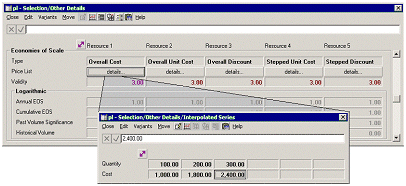
New Price List input for Resources
Another familiar pricing model is to have step changes in batch unit costs, paying
one rate or unit cost y1 up to the first n1 units, and then a lower rate y2 up to
the next breakpoint n2. Select Interpretation = Stepped Unit Cost to define the
price list in this format.
Modelling loans and bonds with individual debt facilities
The STEM model engine calculates Service demand and revenues and the necessary Resource
installation and costs arising from providing those Services. The Results program
calculates derived network financials, including total revenue, cost and operating
profit, and then uses a series of global assumptions, principally Target Gearing,
to calculate a funding requirement and actual debt/equity ratio.
When this approach was introduced, in 1997, the specifics of any external borrowing
were judged to be of peripheral impact on any business case (and perhaps of little
interest to the typical modeller). However, detailed financial considerations have
become increasingly important as pressure has increased to demonstrate real value
from investments. Some business cases may only succeed if at least some of the investment
is subsidised, and variance around some agreed level of financing may be a critical
sensitivity.
In recognition of this new need, STEM 7.0 allows for the definition of individual
debt facilities, with separate terms and schedules, to support the funding requirements
for a network.
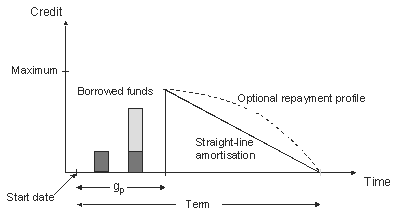
Structure of a typical debt facility
Intelligent formatting options
STEM is a communication tool as much as a capex and opex calculator and in recognition
of this fact, considerable energy has been given to improving the user interface
in STEM 7.0.
Number format and orders of magnitude
A key area for users has been the way numbers and orders of magnitude are shown
in results tables and graphs. STEM 7.0 has a customisable number formatting system
which allows the user to specify:
- an order of magnitude for a graph, such as millions or billions, which will be used
automatically to qualify the y-axis scale
- the number of digits and decimals to be shown in a table
- whether values should appears as percentages.
These options can be applied to individual graphs and tables and are also stored
with all pre-defined graphs in the Results configuration.
The selection of a number format, and especially the choice of orders of magnitude,
depends critically on the actual numbers at hand. In other tools it may be necessary
to manually format each graph or table to suit the specific data. In contrast, STEM
7.0 includes a system that will automatically select an appropriate order-of- magnitude
label and the optimal number of decimals, depending on the actual values displayed.
This system is controlled by a set of global parameters which you can control with
a new Number Format dialog, which is accessed from the Options menu in the Results
program.
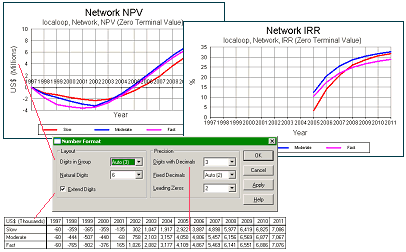
A few simple options control the format for all new charts and tables
Routine preview of inputs with Auto Graph
In the Editor, a chosen input can be graphed by clicking on the Graph button in
the appropriate dialog. STEM 7.0 extends this feature with a window which will remain
on screen and automatically display a graph of whatever input parameter is selected.
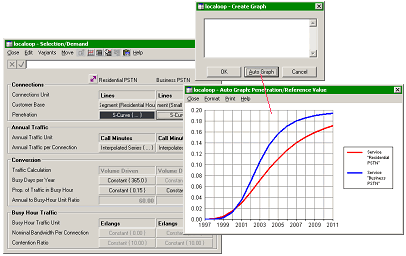
Auto Graph follows the current selection and may be optionally displayed on start-up
of the Editor
Visual grouping with colour blocks
A new option uses blocks of colour to group together a set of model elements. This
makes it easier to see at a glance which elements belong together, for example the
Services grouped within a particular Collection. Colour blocks may be drawn around
the members of Collections, Market Segments, Functions, Dimensions and Templates.
As soon as you add an element to a Collection, a colour block is drawn around both
icons. There is a default colour block style for all Collections in a view, which
can be overridden for individual Collections in that view. Other views are not affected.
Colour blocks may optionally replace unsightly Collection links with bounding rectangles.
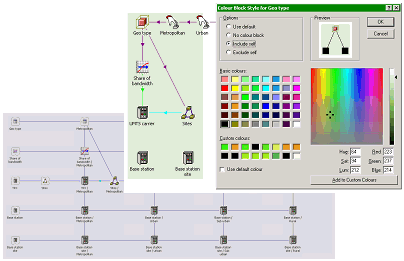
Optionally exclude or hide ‘parent’ icon
Advanced service costing
A defining feature of STEM version 7.0 is the generation of allocated Service cost
results, broken down by individual originating Resources, based on a scaleable implementation
which is designed to avoid a combinatorial impact on performance.
STEM performs detailed cost-allocation through the calculation framework for handling
incremental demand which is generated when a model is run. Appropriate shares of
Resource costs are routed to the respective Services responsible for used and slack
capacity. However, the 6.2 model engine only stored results for the total allocations,
mainly because costs were aggregated by intermediate Transformations before being
passed back to Services (though originally also to limit the size of results files
on disk).
In contrast, STEM 7.0 stores separate results for the costs of each separate Resource
which are allocated to a given Service. No changes to the inputs are required; a
STEM 6.2 model must simply be re-run with the new model engine. In the new Results
program, we have added two new types of result, ‘Service / Resource’ and ‘Transformation
/ Resource’, for which all the usual cost results are available, as well as a Used
Capacity result which can be used to understand respective Service shares of the
installed capacity of a Resource.
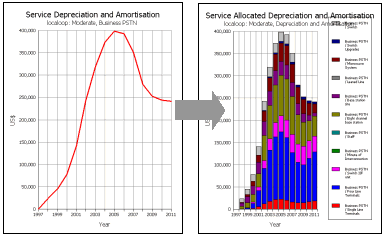
The new system stores separate results for the costs of each separate Resource which
are allocated to a given Service
Direct cost results for tactical pricing
New direct cost results allow for costs driven by intermediate demand from partially
slack equipment, and vary more closely in relation to the underlying service demand
than used cost results. Direct costs represent the cost of a fully efficient network
and are the keenest indicator for tactical pricing.
